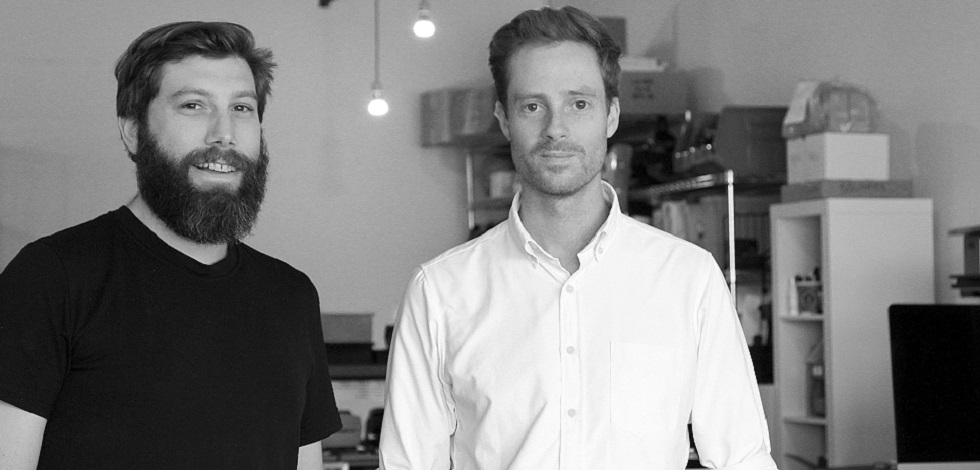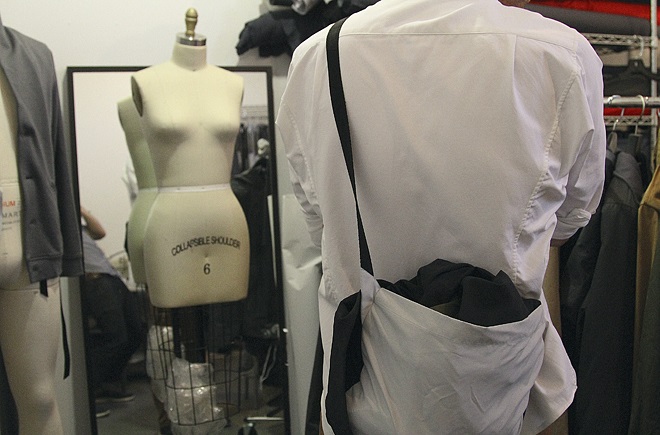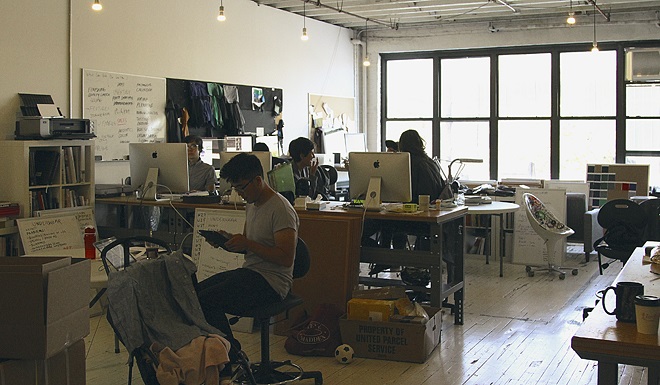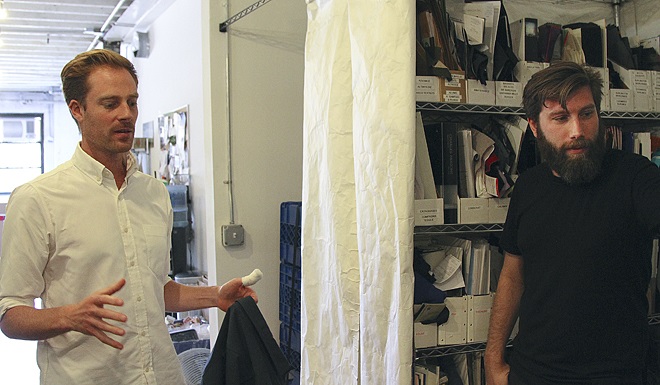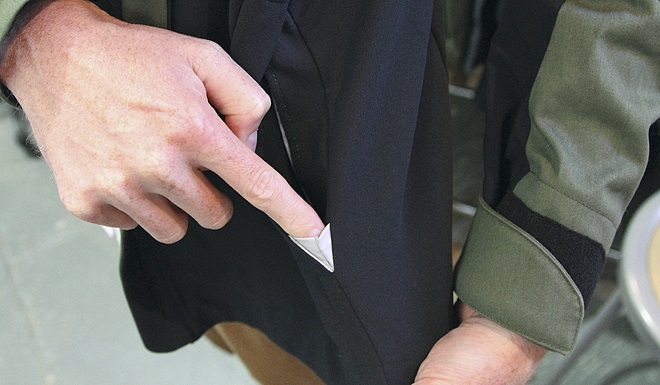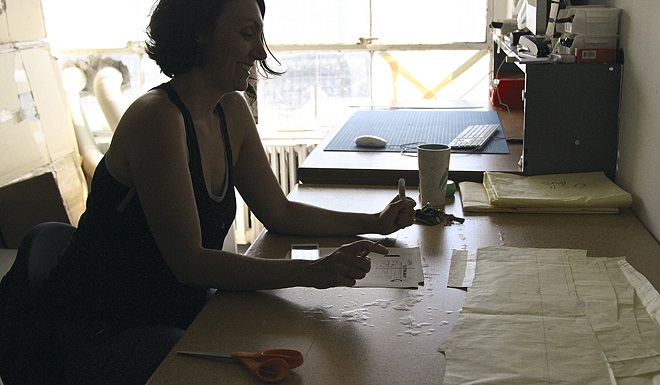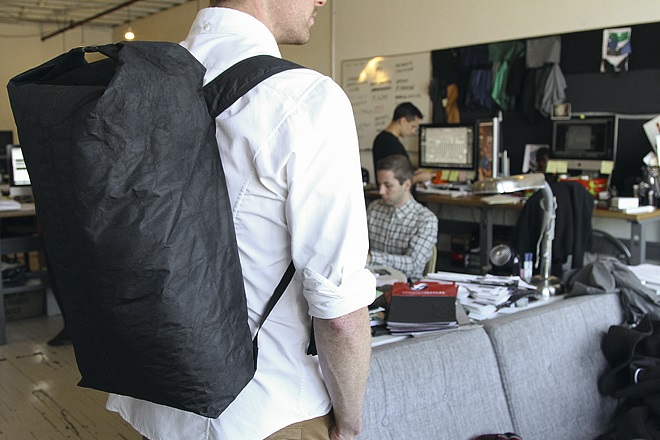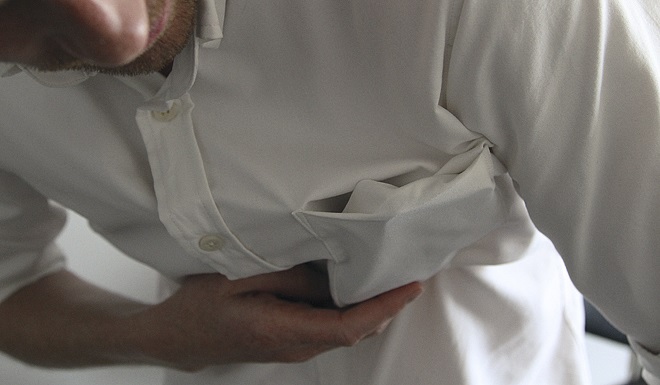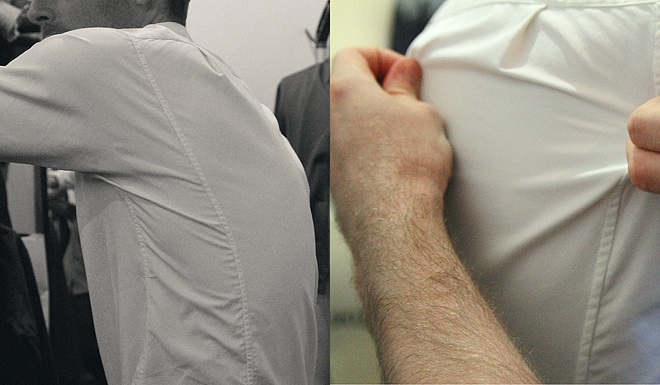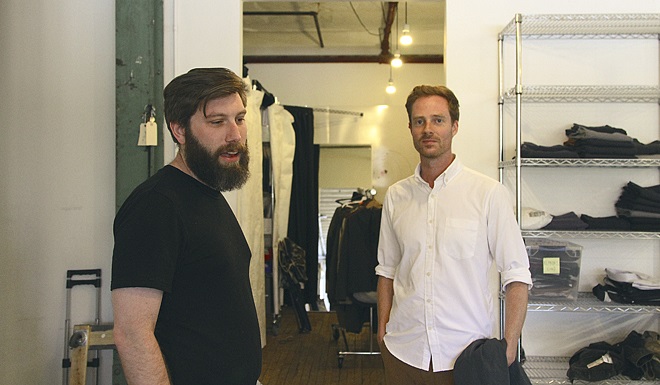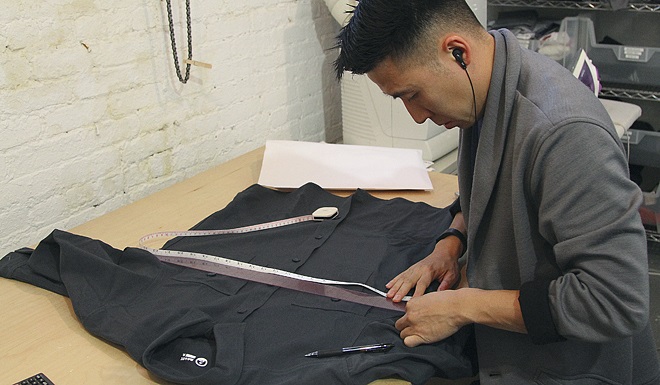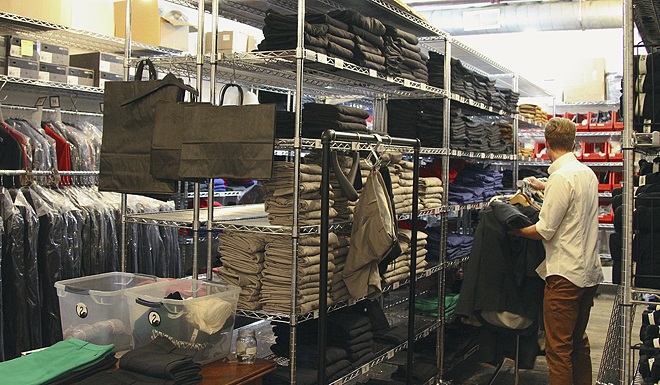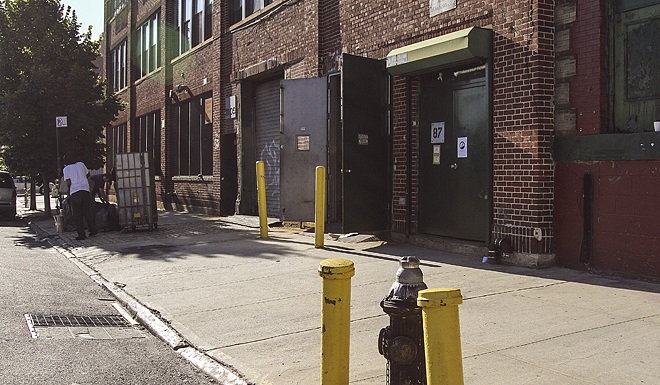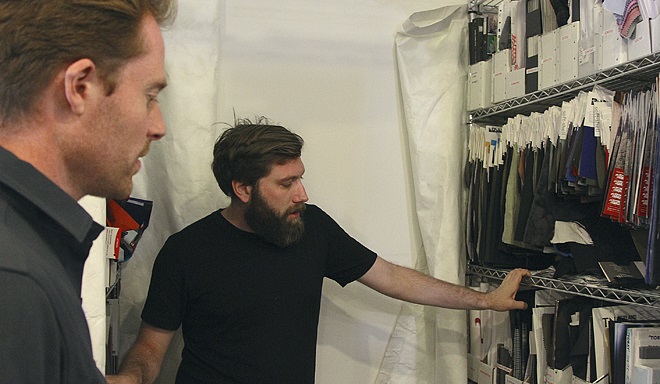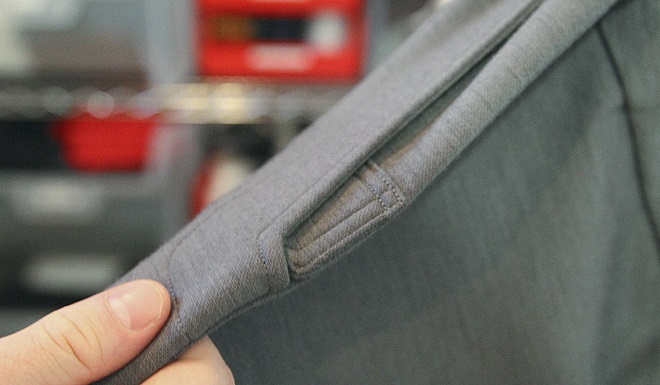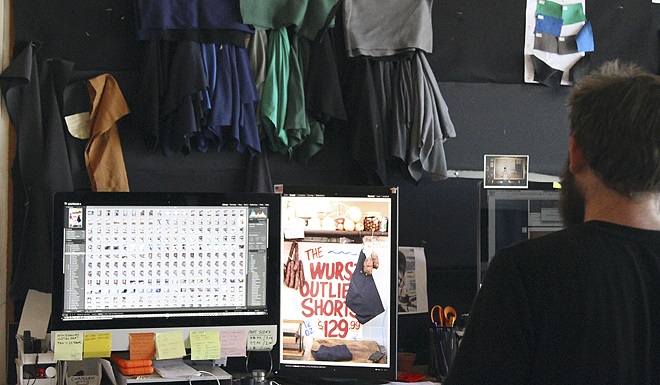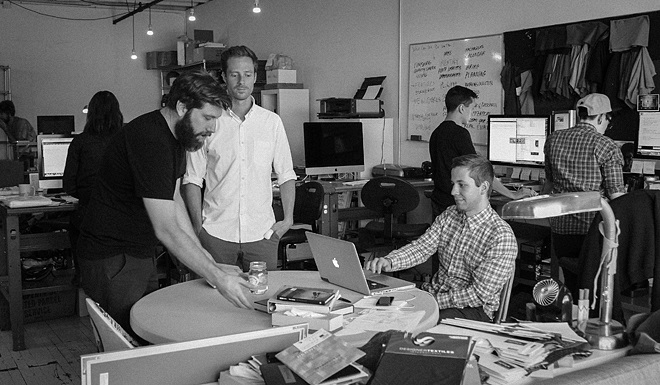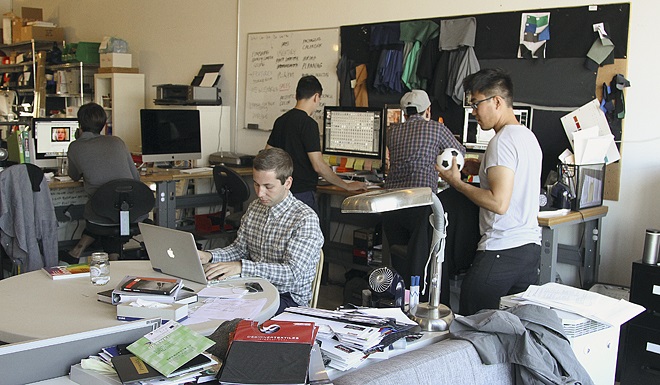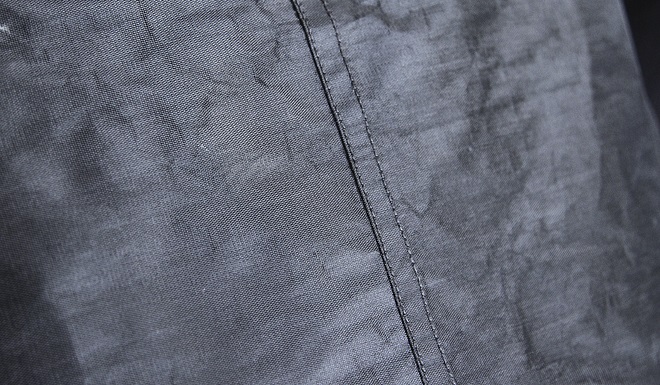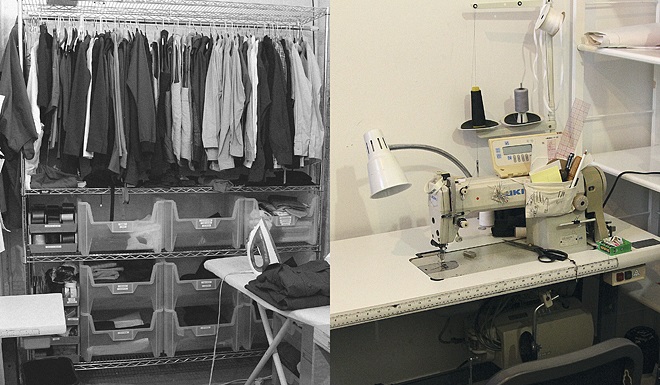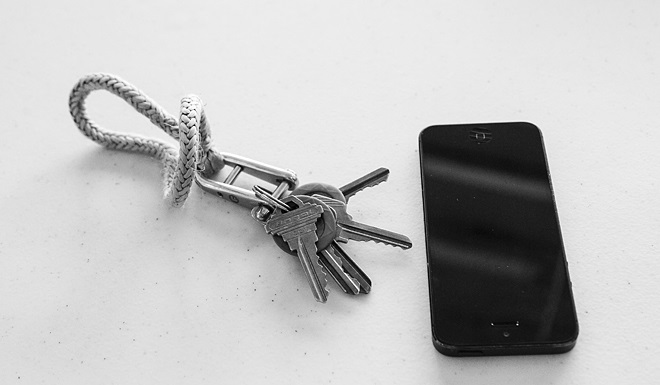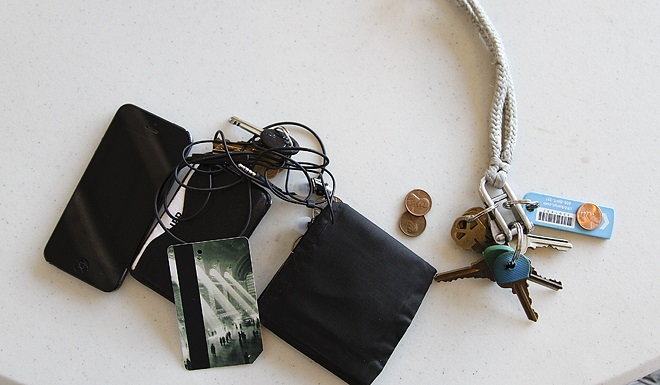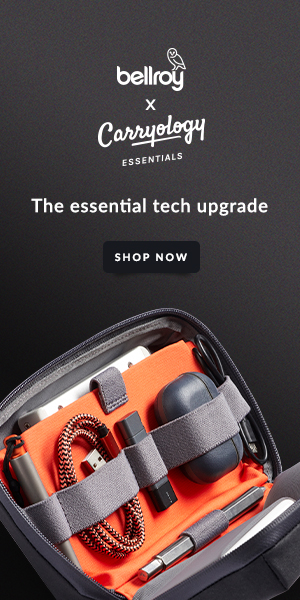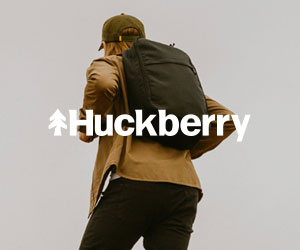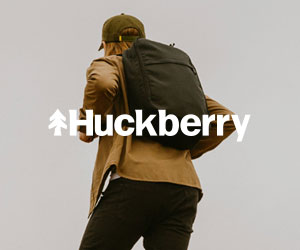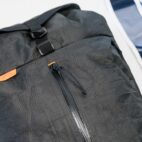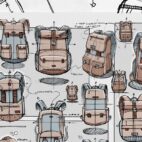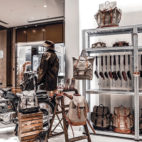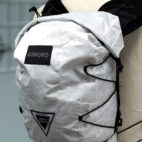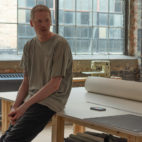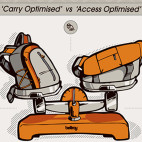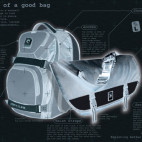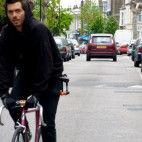An Interview With The Founders of Outlier
Our Outside Influences series talks to specialists in areas related to carry, to see what learning might be relevant within carry.
Outlier have cropped up a few times in Carryology, but we were eager for a proper in-depth interview with the folks behind the brand. While their primary focus is around active apparel, look closer and you’ll discover that there’s more carry to this brand than meets the eye. From their UHMWPE Minimal backpack, to innovative pocket detailing, and a collaborative approach with fabric mills, Outlier are a great example of a small startup changing a whole industry.
Abe Burmeister and Tyler Clemens, the founders of Outlier, let us behind the scenes to talk shop.
Andy: When you guys started there seemed to be a cycling focus to your brand, but now it’s really shifted more into general active apparel. When you look at brands like Finisterre and Rapha they have really kept a specific activity focus, you know, it’s either surf or it’s cycling or it’s something like that. How about you? Are you trying to generate more general active gear?
Abe: We don’t want to be a lifestyle brand, right? So we look at for instance Apple. When Apple makes a product they’re not, “Oh yeah, we’re just trying to make it for 25 to 35-year-olds in this market and there’s this many of them.” They’re like, “We’re trying to make an amazing product.”
So we have customers and most of our customers are in a certain range and live in cities and whatnot. But we have people who are in their 60s or their 80s who love it. And then there are kids who are saving up to buy it. It doesn’t really matter to us.
Tyler: And then the flip for us is that we want to make stuff that we’re going to wear. We’re actually making stuff for us to wear that we love.
Andy: So do you think of you and your friends as, “Alright, here’s our test group. This is who we want to stoke…”?
Abe: It’s just we make it for ourselves.
Tyler: Yeah, and we’re lucky that we have an Online Direct model so we can make a small run. We do prototypes and do a beta run of it and then release it to our mailing list, and get some feedback from them as well.
Andy: That’s the beta run where there’s not as much warranty?
Abe: Yeah, we experiment on products, and what we found is we’d make a few because we’re making locally and we have that ability; put it up, test it, see what happens. And if it sells fast then we’ll make more and if it sells slow, we won’t.
What we started seeing is that if we said it was experimental, people would buy it even though they didn’t want it, just because —
Andy: A limited edition.
Abe: Yeah, or they regret it, or they buy too many sizes and then they return it, and so it was hurting our ability to do this kind of experimental stuff. So now we make it a little more high risk, like “You buy it, you keep it.”
Tyler: So then people who really want it will get it, and they’ll give us the feedback. We get feedback all the time; every day people are sending us e-mails telling us, “You know, I love this about the product but do this.”
Andy: And you seem pretty active on Twitter as well. I guess you see things pop up in that comment dialogue.
Tyler: Yeah, we’re always communicating with people.
Abe: But we also have what we think is a pretty generous return policy. It’s 45 days, any reason, any condition. So in order to keep that – the experimentals were sort of making that policy tricky. And we’re like, “We want to keep that policy as strong as possible.” So the experimental stuff is opted out of it now and it lets us keep experimenting publically. We’re always experimenting internally too.
Andy: Are you starting to get better attention from the mills? I always know it’s hard when you start small.
Abe: The shirt we released, the oxford, that was a custom mill fabric. So that was really cool that we got to work—
Tyler: Directly with the mill; we spec’ed the yarns on that, we spec’ed the weave, we spec’ed the finishing.
Abe: The shirt size is easier to work with because they’re always doing these yarn-dyed patterns and stuff. The shirting mills are better set up to kind of switch and customize, and the mill that we actually work with, they actually also extrudes the fibers themselves. So they were pretty cool to work with.
Tyler: Yeah, they were great. And people at the company really were talking about our company before and looking to us as inspiration for doing some of their line. So they’ve been really open and receptive to working with us.
Andy: So did your oxford come through that program, or once you’re doing your own custom fabrics is it a bit harder?
Abe: It’s a little bit harder but we did it and we did an experimental edition.
Tyler: Yeah, we did a small run and we got some feedback on that. But really, it was our feedback driving that one. It was personally what did we want out of it? And so we went back and we iterated on the fabric and changed the yarn sizes so that they have a little bit more dimension and breathability.
Andy: So pulling them open a little more?
Tyler: It’s just the dimension of it, like the different thicknesses.
Abe: When you have a thick yarn and a thin yarn, when they’re woven together they’re different diameters and you get more space developing in between them.
Tyler: So we went back and tweaked that. And then we did our next run of it and we had an amazing response; people love them.
Andy: In terms of testing, do you try and simulate all seasons? Do you jump in a hot room and sweat it up if it’s the middle of Winter when you’re testing these things?
Abe: A little bit. One of the things we try and do is develop stuff in season and test it.
Tyler: On this one, we did a lot of field testing. We were at it all year round.
Abe: It’s not your middle-of-Summer shirt, you know? But you can easily wear it in the Spring, Fall, and some Summer days too. So that was pretty easy to test. But with certain things it gets tricky. We would look around and like find a walk-in fridge or something.
Tyler: And then when it does get tricky like that, sometimes it’s good to get outside information. So we take it to a place called Vartest and they run standard tests on fabrics, things like dimensional strength.
Andy: Is that side of things starting to increase for you guys? I know often when brands start, it really is going off raw intuition.
Tyler: It is, yeah. I think it’s still definitely intuition, but it’s nice to have the other information because more information makes you…
Andy: It helps you understand why that’s doing that, or why something wore out in the crotch.
Tyler: Yeah, exactly.
Abe: It’s interesting because you can get these numbers and sometimes they mean something, sometimes they don’t. So people talk about waterproof, and you get this water column number and people know there’s a number and that higher is better, but you don’t really know what it means and how it relates to—
Andy: Breathability or…
Abe: Yeah, there is no breathability. So there’s different measurements and we’ve started working with this laboratory which is crazy because it’s in the middle of Manhattan and you could just walk in this huge, old building and the whole floor midtown essentially is just this insane laboratory.
Tyler: It’s amazing.
Abe: They’re testing stuff for the military, and there’s a little biohazard room. So it’s pretty wild, and we’ve been working with them.
Tyler: But also it allows us, now that we have a broader range of fabrics, to test against what we know those fabrics are. So we’re now comparing in our own line, which is nice.
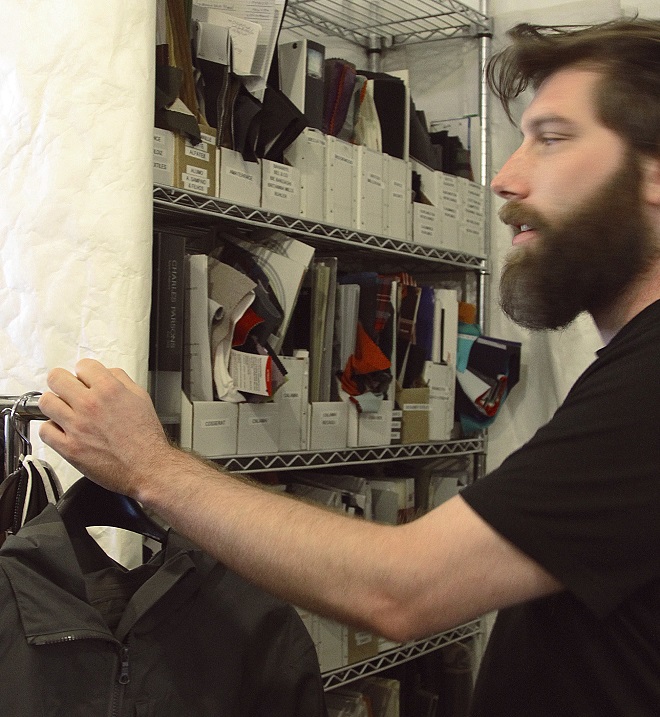
Abe: We never just use a number for the sake of a number. We want to know what it means, right? Some of it makes sense, like pounds per square inch. You can figure, “All right, that makes sense.”
Tyler: We actually haven’t published any of those results either. And we haven’t said this for what it is because we want to build up more of a body of knowledge, and then use that.
Abe: Absolutely, but one of the big things is we’re buying all this stuff from the outdoor industry, and we buy from other industries too but in the outdoor industry there are a lot of people who shop by numbers.
They’re like, “Okay, we need something that does this, this, and this.” And their suppliers figure out how to make that as cheap as possible but you get a crappy fabric. It doesn’t feel good. So we want to avoid that whenever possible, and the whole has to be greater than the numbers no matter what.
Andy: I think one of the funniest things about the outdoor industry is that it’s so much about appreciating nature, and yet all the gear is bright, synthetic, crinkly, kind of noisy. It’s not natural outdoors and it’s really odd. It’s one of the things you guys are starting to fill really nicely and we’re starting to see merino wools come back in, we’re starting to see natural fabrics treated in more tech ways, all that sort of thing. It feels like it’s been missing so badly.
Abe: Yeah. It’s funny because we see the outdoor industry and we don’t really see ourselves as making for that. But some of our stuff is better. It’s not our design parameters, right? So we’re not trying to make stuff you can backpack in but sometimes it’s –
Andy: It actually works.
Abe: We’re using better fabrics.
Tyler: Absolutely. Our dungarees are incredible for hiking…pants for the climbers that are really great for general.
Andy: The stretch, they’re not bad in weather, they dry quick, all those things. I guess slugging it out on a bike is a similar sort of vibe.
Abe: The guys at Juniper Ridge, the soap brand, they wild craft soaps and stuff and they live in our stuff. They go out for like a couple of weeks at a time and are like, “This is the stuff.” So they’re our testers, but at the same time it’s funny because we see all these problems with the outdoor industry – and there’s good stuff too – but we see it and we know but we don’t really try and address it too much. We’re still just taking the fabric and going. But we get to see a lot.
Andy: So thinking about your audience, it feels like your audience really is an urban base because it is mixing work and play, kind of a more active community.
Abe: Yeah. I think part of the reason the outdoor industry is the way it is is because you’re – it’s weird because it’s sort of antisocial – it’s social in its way because some people are out going out there alone but a lot of people are going out there in groups. But they want to get away from people so they don’t really care what they’re communicating to other people.
Tyler: The outdoor industry is also built for the extremes, right? Building for expeditions on Everest. But that’s not what you’re doing every day and so that’s not our customer. We want to design for every day like we live.
Andy: Yeah, that makes a lot of sense. So, Fridays you open up to everyone and let them come in and try things out. Is that really interesting for you guys? Do you try and kind of eavesdrop in and overhear…?
Tyler: We actually find ourselves helping.
Andy: And in terms of your business, I guess you guys are managing pretty quick growth as well?
Abe: Yeah.
Andy: Is it fairly frequent hiring at the moment?
Tyler: Right now, yeah. It’s starting to get into a busier season for us.
Abe: We’re bootstrapped so our ability to buy fabrics constrains our ability to grow. But there’s a lot of iterations on stuff we’ve been developing or have developed and we have a seamstress who is working four days a week, and we’re building almost all our prototypes in-house now which is great. Stuff just gets made, and we can test it and play around. We’re making almost all the patterns in-house now too.
Andy: Yeah, so it’s still really an apparel focus. However, you guys are starting to do a few more collaborations on accessories. You did the original collaboration on the Minimal Backpack. So how do you decide when to try and do it all in-house versus external collaboration?
Abe: It’s very collaborative, so we debate what we want to focus on. The whole company is involved in that and it’s really where the energy’s at. If people are excited about something, and we don’t care if it’s apparel or what, if the energy’s there then we’re going to run with it because we want it to be fun.
Tyler: But in the case with Mike [Mike St. Pierre] at Hyperlite, it kind of fell in naturally because we had met him at Outdoor Retailer. We really enjoyed hanging out with each other, and we liked what they were doing.
Abe: Yeah, we were one of their first customers. We were looking at the fabric, the Dyneema they were using. And then we were talking to the Dyneema people, and they had one of the bags, and we were like, whoa, that’s where we should be happening.
Tyler: So it developed pretty organically. But the great thing with them was that we couldn’t actually make that ourselves. So we brought something to the table and they brought something to the table, and we actually made a pretty cool product.
Andy: It’s sold out at the moment. Is it going to come back, are you reworking it a little?
Abe: The Minimal will come back, at least one run of it.
Andy: One of the things about Ultra High Molecular Weight Polyethylenes is that because they are so hard to work with they’re so often very minimal backpacks. Whereas I guess a lot of your customers are commuting with a laptop, with a bit of tech, with a bit of other stuff. How have you balanced that?
Abe: We did another pack with them this Summer. It was a version of the Windrider, we kind of stripped – the same thing we do with the Minimal. Well, the Minimals actually were the ones we told him to make in that fabric. We knew he was making bags but we were like, “Take the fabric you’re using in this bag and put it into this bag.” He was making it with the non-laminated stuff that’s just Mylar and Dyneema, and that stuff is strong but it wears through relatively quickly because of the Mylar. And then it looks like a plastic bag because it’s Dyneema encapsulated in Mylar, right?
Tyler: It was cool though. But we helped with making the strap a little bit better too and that kind of stuff.
Abe: Yeah. A lot of when we work with Mike it’s just taking what he’s doing and figuring out how to strip it down so that our audience is going to appreciate it a little bit more. People are going into the backcountry and they need certain things, and a lot of those packs are specified for very particular activities.
Andy: A lot of them are still custom-made. It’s like going up K2 you’ll kind of get every little detail custom designed for you.
Abe: Yeah, we feel like Graham [Graham William] at Cilo Gear in Portland, you know, a lot of this stuff is pretty awesome. Really spec’ed out.
Tyler: For the Minimal we wanted it just to be stripped down but also have the ability to pack up to a really small size. So when you have that design parameter, you don’t want to design for laptops. Actually, our stance on laptops is that we don’t commute with laptops ever. We use everything through our phone. So there’s not much use to design to that.
Abe: We try and avoid really tech-specific designs. We want to be as useful as possible, so we try and make things that are a little more versatile. It’s the same with pockets on our jackets; our philosophy is more stripped down. And one of the key things we do is psychologically we want the pockets to be distinct to avoid when you’re trying to find something and you’ve got so many pockets you don’t know which one it’s in.
Andy: Are you expecting people to ride home with a phone in their pocket with keys and some coins and that sort of thing?
Tyler: It depends on where you put it at. We put it here [indicating front shirt pocket], so we actually developed this little catch-flap thing. So it goes over the top of whatever is in your pocket, so if you do lean over it doesn’t come out.
Abe: Our pockets are always designed to be deep so things don’t fall out.
Andy: Pocket design is just one of those things that so few people have really thought much about. The way you’re describing using your product, there is this feeling of really believing in your product.
Abe: Yeah, so with our sweat pants we built a catch which is pretty discreet. And then one of the things we like to do a lot is build these kind of secret stash pockets. That really came from when you’re riding your bike around and you don’t have a bag and you think you’re going to be home soon or whatever, and then you want to buy a magazine or eat a sandwich or grab a beer or something. It’s not built for long-term carry, but just to have that quick pocket you can throw something in and get it to your next location.
Andy: Without it compromising the garment really; it’s light, it’s slender. So it feels like a major part of how you guys started was fabric insight, to really understand the fabric performance. Are you starting to move more and more onto these construction insights?
Abe: The construction came in pretty early, but the fabric’s what made it work from the get-go. We fell in love with the tech fabric, and it’s what made the very first products. But you know, we had this Pivot sleeve, and this was kind of our…
Tyler: This was us playing with form and design, and using the fabric in its natural stretch in the bias to really loosen up and really allow movement.
Abe: It’s partly the bias, but a lot of it’s the construction. We’re limiting the seam here. Usually when you pull forward, it starts pulling across the back. By eliminating that seam, you get rid of that. And then the bias gives you extra stretch. But it’s not even necessary.
Tyler: And you know we did gussets in pants.
Andy: Yeah, it makes a difference. Funny enough, I’ve ended up in some Levi’s Commuters where they’ve reinforced the crotch. But the way they’ve done it is downed the hell out of the inside, so it tears apart your inner leg when you walk. It kind of really grates on you. They’ve built reinforcement on the inside, but they’ve then zig-zag stitched the whole lot to get it in, and so it kind of just starts rubbing. [Laughter]. It’s not quite resolved, but this is Levi kind of playing in your guys’ space. They’re starting to go, alright, well let’s think about it more and put a bit of stretch in and put some stain resistance in, put a bunch of actual features in.
Abe: They’re stopping using the NanoSphere. The NanoSphere is what helps things roll off, like the water resistance, and it’s because Greenpeace really targeted them about sort of chlorofluorocarbon treatment. So they’re going to be switching to something else which won’t work as well. It has good water resistance. But it doesn’t have any of the oil resistance. So it’s going to be interesting to see what happens.
Andy: It’s funny with that stuff, I was talking to some Nike designer friends really recently, and they were saying, “Yeah, occasionally we see these fabrics that are amazing! And other brands are using it.” And they’re like, “If only they didn’t have really bad labor practices or terrible influences on the environment or whatever,” and Nike have been really disciplined with holding back and not using these fabrics that they’d love to be able to but they don’t complete the picture.
Abe: An Italian company makes our rivets and shanks and stuff and they have this amazing matt-black finish and literally they have a little sticker that says, “no eco” on it. They tell us, “No, you can’t sell it in Japan. You cannot sell a product with this finish in Japan. It’s so bad for the environment.” So we always look at it, and we’re like, “God damn!”
Andy: It’s so hard to get metal finishes in black that look great and hold up and don’t chip off.
Tyler: We don’t tend to have that problem with fabrics so much though because we’re working a lot with Schoeller and designer textiles…
Andy: And they’re already Euro standard, the whole deal.
Abe: Yeah and some of them set the standard. But the Europeans aren’t angels when it comes to chemicals either, you know? They have certain higher standards and certain things are just like, “What?”
Andy: Yeah, totally. Do you guys have a philosophy with what you’re trying to do there, like avoiding toxins or trying to find things that can be recycled…?
Abe: We want to make the best possible product, and that means considering everything. So we’re pretty lucky in that a lot of our – like the Bluesign standard came from Schoeller, right? And so Schoeller had been thinking about this stuff. They’re in Switzerland, it’s landlocked, they care about the environment and the pollution and that helps a lot. And then the merino stuff, there is different metrics, but most people rate it pretty highly in terms of the environment. When they rate land, when they consider all land as being equal, it gets bad environmental things. But if you consider what you could be doing with the land otherwise, then all of a sudden it has a great environmental incentive. A cotton field could be used to feed the world, right? If the mountains where the sheep were on, like there’s –
Andy: But I’ll tell you, in many parts of New Zealand if they’re not putting sheep on that land, the land’s empty. It’s some form of livestock; there are not enough people to fill it and there’s not as much crop farming.
Tyler: It’s definitely a big consideration in our design. It’s not something that we promote because what we’re trying to do in the end is just make a better product of what’s on the market. And that is a lot in terms of the function of fabric and how it looks and the feel of it. It’s not the eco story behind it; that’s a part of it. The labor practices behind it are part of it. But really, it’s about the product.
It’s like when they pushed organic cotton like crazy and then –
Andy: Now they’re going more and more synthetics, and just getting away from that because of all the water issues.
Abe: And when you look at cotton that’s organic or that’s not organic, well organic cotton takes up twice the land to grow the same amount of cotton, so yeah, it’s tricky. So we try and make the best choices we can. We certainly don’t try and hype it because we don’t know what’s up, and ultimately it’s just like that’s the best.
Andy: And the longer the garments are actually used and loved, the less harm you’re doing anyway.
Abe: And then the NanoSphere that we put on a lot of stuff, right, it is a chlorofluorocarbon so almost none or any of it ends up in the atmosphere because it’s closed-cycle application or whatnot. But yeah, it could be a better chemical in what the long-term effects are. It’s tricky. But then it also means that you don’t have to dry. This stuff dries so quickly. And something like 80% of the energy used in a life cycle of a garment is in the dry cycle. It’s in the wash too but mostly the drying, especially if it’s electric, it’s just tons of energy to heat up this thing and spin it around really fast. So you get lots of give-and-take. But yeah, we try and make stuff that lasts longer and works longer.
Andy: Yeah, and then you avoid the obvious harm, you avoid the obvious human toxins and it sounds like a good approach.
Andy: I’d love to get some insights into your retail. Do you retail through anyone or is it all direct Internet and kind of open studio?
Abe: We used to have sort of a one-store-per-city kind of approach but we found that we weren’t very good at wholesaling.
Tyler: It took away from our focus. There’s a lot of other things happening when you’re a brand; you’ve got to build products, you’ve got to – there’s lots of stuff to do.
Abe: We weren’t treating the people who were wholesaling our stuff right. We had sort of built this system where they could tie in to our retail system and if it was available on our website they could buy it and sell through their shelves but there was no pre-order and we didn’t have an infrastructure. We looked at it and we were like, “Well, if we’re going to do it, (A) the more we wholesale, the higher the price is going to have to be. And (B), if we’re going to do it, we better do it right, and we’re not doing it right, right now.” So we just killed it.
Tyler: We took a different approach in the beginning because we didn’t take an order and then go and produce it. We just sold out of our stock. So our wholesalers would get the e-mail that we released something, but then all of a sudden stuff starts selling out before we even get a chance to ship and we thought this is a big problem. We don’t work on that schedule.
Abe: So we focused. We found it’s better to focus on what you’re good at, take it one step at a time, and see. We might re-open it at some point. I really don’t know. But right now, online works.
Tyler: Retailers tend to work on more of a seasonal basis as well. They want to bring out loads of stuff at the beginning of the season.
Andy: It’s kind of a push model where you guys kind of just want a pull model.
Tyler: We’re bringing in new product and selling it this week, and then next week we’ll have something else going on.
Abe: Since we’re doing everything locally we take delivery basically every week, sometimes twice a week. Stuff is coming in and so we can just try and move quick and be light.
Andy: Has that meant you do much less stock clearance than a lot of other people?
Abe: Yeah, we do almost no clearance. Every once in a while we have a product that doesn’t do as well or whatnot. But we don’t really go on sale.
Andy: That feels nice, doesn’t it? People are buying for the right reason, not because it’s discounted this week or something.
Abe: Yeah, and we also did a few things really early on where we realized how powerful the discounting was, and we were like, “We’re going to stay the hell away from that.” It felt like a downward spiral.
Andy: You train people to it.
Tyler: It’s like you’re adding gasoline, right? It just burns away really quickly.
Abe: We sent an e-mail that we shouldn’t. Something went down on our website and we sent out an e-mail even though our site wasn’t quite working, and we knew it, and we thought we could get away with it. We realized that we fucked up, so with apology we sent out an email – it was like maybe a 10% or 11% discount, and people went nuts! And we were like, “Whoa! People go nuts on 10%?” Well yeah, if there’s never any discount. And we were thinking that’s how you end up with 80% off all your stuff. We didn’t want to go that route.
Andy: It’s especially strong in step-up brands; where you’re charging enough that you’re avoiding obvious compromises, but you’re not yet paying for exclusivity like luxury brands do. And in that step-up brand space it’s often just a little bit more than, you know, the sport brands of the youth, the mass retail chains of your mass market. And so many of the brands in that space such as Jack Spade, Nau, even Patagonia are at those sorts of price points. If you take 30% off, all of a sudden you’re the same price as the mass market and so it’s a lot easier to sell. And so many of those brands are almost training themselves into this vicious local discounting.
Tyler: We’re just trying to build products that have exceptional value. So that’s what we try to communicate to our customers. When you were talking luxury, they’re talking about totally different mark-ups. They’re doing like ten times our mark-ups. It’s just really ridiculous. We’re not in that space.
Andy: But in terms of value for the customer, that direct-to-consumer is a radically different proposition for you guys because you don’t have to double it in the middle for a retailer.
Abe: Only 15% of retail is online, so most people will never buy anything unless they can touch it and try it on. So there’s value and it’s going to get really tricky for the stores because brands even if they have huge wholesale channels are like, “Wow! I get the whole thing if I put it online?” I think there’s going to be a crisis point for retail…but there’s still real value. There’s value just in the experience and there’s value in trying things on and there’s value in the customer service. So something’s going to have to happen in the retail world.
Andy: On a related note, have you done your open studio for a while?
Abe: What happened was we actually had a space, we called it our public showroom. It was across the street. It was literally our friend’s apartment but it was a ground floor apartment with a retail space in the front. And they gave it to us for very little money.
It had no walk-by. It wasn’t on a major street; it was on a residential street. We just opened it up on the weekends. First we didn’t do anything with it. We had it as storage or something. But we would open up on the weekends, and it did really well. And then they sort of realized eventually, “Why do we need a retail space in our apartment rather than a bigger living room instead?” So they kicked us out and then we were like, “Okay, let’s get another space.” And then we realized, “Wow, this is way more work than somebody giving you a space.” That’s where the open studio came in because we loved being able to talk to the customers and have that level of communication. We thought, “All right, let’s just open the studio up.”
Andy: Do you try and get most of your staff interacting with the customers and trying to help out, or do you try and not distract them too much?
Tyler: Actually, we ask the staff weekly, “Okay, who wants to work open studio?”and it’s always a different set of people. It’s a different dynamic and people who don’t get to work together often during the week get to work together during open studio. It’s really interesting because customers come in and give us feedback on things. They’re coming in from all over the world; they’re just really cool.
Andy: Totally, because one of the hardest things of only being direct-to-consumer through online is online you get to measure all these things better than you can in a retail store but you’re missing out on all those really intangible human aspects.
Tyler: You normally never get to see the fitting, right? Even expressions that people have when they put something on, they’re doing all these movements and they’re like “Wow, this is amazing.” It’s always really helpful to see.
Andy: So to get back to the bootstrapping element, are you working on smaller MOQs [Minimum Order Quantities] with your suppliers where you can pull it down – like say the custom oxford, do you have to pick a couple of products to put that into to be able to consume?
Tyler: Well, that’s the really big question, and what we did is we set up the yarn direction so that we could get different colors out of the wefts. So instead of having to order like one thousand of all one color, we set it up differently so we could get colors out of it. We used that knowledge to be able to allow us to get into it.
Abe: We work with expensive fabrics so the MOQs tend to be a lot lower. So it hasn’t been a huge problem. The biggest problem is when we try and use American fabrics. The American fabrics are so geared around the military, and some of them are great. We have one product that’s a hundred-percent American-made. But we can’t get colors, and we basically have a blue and an olive because it’s like Air Force One.
So we’ve been trying – and I think we’ve kind of cracked it, knock on wood – but we’ve been trying for a while to get reasonable quantities out of those guys. And that’s a different price point. When we’re selling things for $200, it’s not really an issue. But if we wanted to sell hundred-dollar products, then yeah, it becomes a big issue. So we’re just trying to grow into it. But so far we work where we can and we have a tendency to pick the most expensive fabric.
It’s crazy. Even with the merino, we didn’t even realize – we’ve been doing all this merino stuff for a while and knew we were using 17.5 micron which almost nobody else is using. We finally sat down with them, I think it was last Winter, and we were like, “So, do you have stuff that’s more expensive than what we order?” And they’re like, “No!” We never even thought about it like that. They’re like, “Yeah, you have our four most expensive fabrics over there.”
Andy: So you guys are kind of self-taught in the materials world then? What’s that learning process? Is a lot of your learning from the suppliers?
Tyler: Oh, absolutely. Trade shows, talking to people in the industry. It’s unbelievable how much you learn. The four days that you’re at a trade show you can learn more than you could in six months reading about it.
Abe: There’s some fabric salespeople that are really knowledgeable but for a lot of the time they’re just salespeople. But if you go to a trade fair, not always, but often the technicians are there too so we’d always try and talk to them about it. And they’re really happy to share their knowledge because they don’t have that many forums to be talking about this stuff. So they tend to be amazing when you sit down and talk to them.
Tyler: I think we’re developing a little bit of a rep now for wanting more knowledge about fabrics and everything, so now our suppliers will bring in other people for us. We also have an interesting professor from Taiwan who sought us out and started talking to us about fabrics.
Andy: That’s an exciting reputation to have that you guys actually care about this stuff. Have you had to try and supplement that, or can you pick up the key parts of what you’re shooting for and trying to understand?
Tyler: Yeah. I mean, wearing the stuff, right? I’m sure you field test everything? It’s really important for your understanding of the fabric and the intimate knowledge you can get behind it. Also pulling it apart; just diving into every aspect of it.
Abe: I remember when I really didn’t know very much and I was sourcing fabrics because I knew I wanted certain properties and whatnot. And we’d be working in the factories where we were learning production from them too and I remember a certain factory owner would poke needles through and be like “This is really good fabric.” And I’d be like, “Well, I don’t know if you’re just trying to butter me up or if it’s real.” But we’ve had some luck and I guess we had a sense for it.
Andy: Skill tends to follow desire.
Abe: Yeah, and that was one of the things we got really into. When we first started, it was very purpose-driven, problem-solving and stuff: how do we make a pant that we can bike in and that handles the rain and doesn’t fall apart. But then really quickly we both realized that there was this whole world of fabric that nobody was using. We just assumed, “Oh Arc’teryx, they’re the best, right? They’re using the most expensive outdoor fabric out there.” No, they’re not. We know they use good fabrics, for sure.
Abe: Yeah, and their pattern-making stuff is just incredible, production is incredible.
Andy: Their pattern-making is probably some of the best in the world. It’s just phenomenal.
Abe: And the production is the best in the world. That’s what I’m saying, right? They have a certain amount they’re willing to spend for GORE-TEX and then that’s kind of the cap. They’re like, “If it costs more than GORE-TEX…”
Andy: We can’t do it.
Abe: Yeah. And so that was kind of a shock.
Andy: So then in terms of increasing your knowledge, if you consider the likes of boardshorts for example, where people have had to solve the inseam because you rub in them when you’re hot and sweaty and wet; thinking about how are boardshorts building that without twisted filament and they’re using straight pull filament instead. In a similar vein, have you tried to go through and say, “All right, well fishing guys solved the water submersion and surf guys solved –”
Tyler: That is what we do, we learn from every industry and every activity and everywhere we can. So we’ll learn from the military, and we’ll learn from fishing. And in terms of boardshorts I think we were looking at one recently as like a button attachment, you know? It’s just something that could make our button attachment system better.
Abe: Yeah, we’re always looking and we look from everywhere from high fashion to everything in-between, and some of it has nothing to teach us and some of it has crazy things to teach us.
Andy: It’s one of the nicer things about being at the front of an emerging niche where it’s not as obvious to just look at the competitors. You have to actually ask who else is there to look at because you’re trying to carve something a bit new here.
Tyler: I think if anything we try not to look at competitors, you know?
Abe: It’s good to see what they’re doing but they’re going to be in their process, and we need to jump out into some other insight.
Andy: Yeah, definitely. So, now that you are starting to hire a few more people, are you guys essentially the ones that set the briefs and then other people play with ways of getting that right, or are you pretty hands-on still?
Abe: We’re pretty hands-on. We set everything up as a kind of flat hierarchy. Neither of us had real experience when we started, and so we wanted to create an environment where anybody could make garments if they wanted to. We obviously hire people with a lot of experience and people with different experiences and whatnot. They have the skills and their expertise but we didn’t have any, so we wanted to create a space where anybody could contribute. If people have good ideas or reasons they think that something can be improved. They can make it happen. Anybody can make it happen.
So essentially teams emerge around given projects and it can be anybody in the company, whether they’re packing and picking or working in the factories, or they’re a master pattern-maker, or whatever. And those teams come together and sometimes we’re on them, sometimes we’re not.
Tyler: But with that said, we love getting our hands dirty and diving into problems and figuring them out, and being the ones at the start of that. So you’ll find us in the factory, you’ll find us doing all kinds of things everywhere. And I think that culture is definitely part of everyone. Everyone feels it and so they want to dig into things. So they form teams, and people will start researching.
Andy: Do you guys still have that love where you were originally the pant guy [Abe] and you were originally the shirt guy [Tyler], do you still have that little influence or is it a broader focus on the whole thing?
Tyler: We love clothing, we love products.
Abe: He’s got more shirt expertise than me. He’s got as much pants expertise – but then also it really depends on the problem we’re trying to solve.
Tyler: Yeah, there are some products that you like more than I do and there are some products that I like more than you do. However, most of the time we’re coming together and trying to make stuff that we all love.
Abe: The most important thing for me, is to put together a team of people who really care about what they’re building and then good product will come out of that.
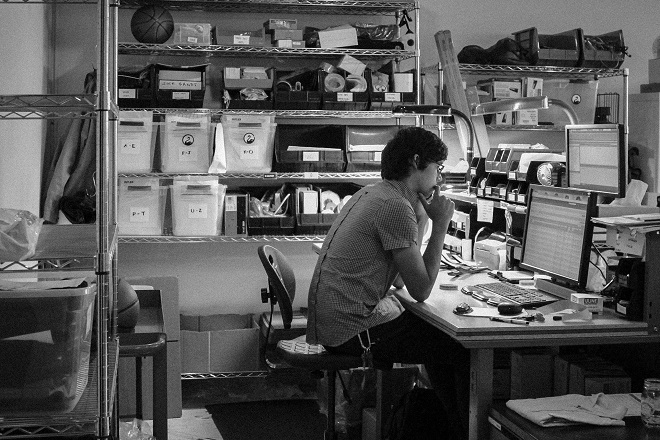
Andy: Yeah, awesome. But getting back to carry, you said you might be rejigging the Minimal Backpack a little. Are there areas where you have more desire to claim that carry space a little bit more and get bags more resolved for different roles?
Abe: Do you know the company George Guest at all?
Andy: Oh, you bet. George Keeler, yeah?
Abe: We’ve been working a bunch with them. [Indicates bag] This is not the latest composite. He went on vacation so he’s like–
Andy: “I’m taking it with me.” [Laughter]
Abe: We’ve been really playing around with our own thing. It’s still in development. And then the newer version we’ve done is at least one-and-a-half versions after this. But it’s been amazing. It’s huge. It’s a roll-top, but it compacts down to almost nothing.
Andy: Are you finding a way to keep the roll together when it’s filled with stuff?
Abe: One side is longer than the other so it rolls and then it has the magnets too; there’s a couple of sets of magnets.
Andy: There was a rad Nike NSW duffel, that had a similar vibe to this. It was essentially a weekender roll-top, but one of the issues was if you picked it up by one strap and gave it a yank, it would pull the roll open. Even if you’d fixed down and anchored them to the side points. So with a larger load you’d grab one strap and if it was quite full, the whole thing would pull open. So crew were getting their bags rolling off on baggage carousels and everything was spilling out and that’s always been one of the hardest things to solve with the roll-top weekender.
Abe: I think it’s not that bad with this fabric because the Dyneema, or really it’s the Mylar aspect of it, it has so much structure that it folds really cleanly and gently.
Tyler: But George definitely worked on that.
Abe: Yeah. And George has been doing roll-top stuff for a while.
Tyler: The great thing about this is the way it’s folding too, right, so that when it closes up it naturally resists to go this way – so it’s intuitive when you start rolling it. And then it clips in because there’s a magnet. So it keeps going. It’s telling you, “Go this way.”
Andy: My biggest grief with weekenders is that they’re not adaptable enough because so often you want something small or something big, and you end up with two or three bags to do it.
Tyler: And then a lot of bags are heavy. You’re just carrying the weight of the fabric of the bag itself.
Abe: And these panels are glued in on this one; with the newer one they’re removable.
Andy: Nice, so you can easily throw that in your larger wheel bag or whatever, and that’s your overnight.
Abe: It also it grows to pretty damn large. And then the strap’s going to be pretty cool. We’ve been working a lot on that and the strap has a lot of interesting stuff going on.
Andy: Arc’teryx on their Covert cabin bags have a fold-up shoulder strap which is a really thin high-density foam that folds in half and tucks into a pocket. It takes up almost no space, there’s none of the normal bulk, but it just makes it radically more comfortable. That would be worth scoping just for this sort of thing where you are trying to keep it really lightweight.
Then with regards to your reworked Minimal Backpack, what are the key differences between it and the older version?
Tyler: The older version didn’t fit right at the back. Now there’s an added link that gives you a little bit more space to fit better around your shoulders. And then the newer version is a lot like the old Minimal in that it just rolls down into your hand. But it’s got our updated hardware on it. So we have some Duraflex in there which is nice. And then we’re using a CT9. It’s a Cuban tech-fibre. But the outer face is a higher denier polyester, so it gives a little bit more abrasion resistance than the last one and I haven’t had any breakage issues. Sometimes, I’ve poked holes in the other one but this one I haven’t had any.
Abe: We ended up using stuff, sort of like how Cilo uses this grade of outer, and then they use a lower count denier on the inside. And then Hyperlite likes using the higher denier but then they use a really thin…like the white stuff is really too thin. So we finally dialled the outers.
It’s been a couple of years since we released them and one of the things we’ve found is that the whites get pretty dirty. So some people were giving up on them.
Tyler: And like I said, we weren’t exactly that happy with that fabric configuration. That’s why we opted for the higher denier in this one for a little more abrasion resistance.
Abe: I think the one thing with this is we’re not going to make a ton because it’s a pretty expensive bag so we’re just going to make a few of them.
Andy: That’s understandable. I’d love to talk about inspiration for you guys. Do you spend much time on blogs or much time kind of trawling…?
Abe: We’re on the Internet but we prefer things like art.
Tyler: There is some inspiration with colors out there, actually. You look around the office you’ll find everything from photography and art to books about color and business books.
Andy: How are you guys going with the business side of it? Do you have good support or is it hard? I’m thinking in terms of the business model: getting the accounting, getting the nuts and bolts, managing cash flow.
Tyler: Well the business model seems to be working in itself.
Abe: Yeah. We’re bootstrapped and we buy fabric, sew it up, make things, sell them, buy more. So far it’s gotten us to this point. We’re still a pretty small company, but…
Andy: Just loving it?
Abe: Yeah.
Tyler: We don’t have anybody to answer to either. We didn’t take any outside investment so we’re not forced to do things that we don’t want to do. So that really helps a lot as well.
Andy: I can imagine it’s been pretty quick growth for you guys lately. It seems like you must be doing pretty well?
Abe: Well, it’s been five years now. When we first moved in here it was nuts because we had been working full-time doing it in our living rooms, and now I’m like, “What? Wow! Am I really here?”
It was just this room; we didn’t have a back space. And then from there we just kept trying to learn and so far so good. It’s a terrible business if the cash flow is going crazy but we’ve been able to get through so far.
Andy: Yeah, and again that direct-to-consumer is better for you guys. The credit cards pay almost on the day that it ships and that’s not indenting, that’s not getting 90-day terms…
Abe: Yeah, exactly. We’re not chasing debt or dead-beats around.
Andy: That’s a huge stress for a lot of startups.
Abe: Yeah. Especially early on when we used to be pre-selling things. We try not to do that now. We learned the hard way that promising something at a certain date when you don’t have it creates its own problems, even if it solves a certain cash flow problem or whatever.
Andy: Especially if you have your own standards reasonably high and you want to make sure everything’s working out.
Tyler: It makes it hard for shipping too because some things are here, some things are not.
Abe: For the most part I think we got really lucky. Starting on the Internet is how we did it, right? So because it was such a wide-open space we were able to carve out a niche.
Andy: And I guess your perfect consumer, your perfect target consumer, your edit point, is online. It’s the urban person, the professional looking for something a bit more creative.
Abe: Yeah, and we make clothes where if you want to read about them there’s a little bit of information, it’s there and you can dig into it.
Andy: Yeah, that’s great. We’re always interested in discovering more about people’s pocket contents and to wrap up, it would be great to see what you guys carry daily.
Tyler: That’s it.
Andy: [Laughter] Yeah, that’s hot.
Abe: You don’t have any money? You took your wallet out of your pocket, huh?
Andy: That’s so much fun.
Abe: This is not in my pocket. It’s on my belt basically.
Andy: Great, thank you. One of the reasons we’re trying to do these Outside Influences interviews is we’re still not sure what the carry area really is. To me, you know, pocket carry is massive! It’s a really key thing. Taylor interviewed Traveller Denim Co in Austin who really think about pockets in their denim, like how to angle them to get things stacking right, and how to split. They’ll do custom pocketing for everyone. For us as wallet people you hope it sits one way, but where does your key sit next to it? What happens? You don’t want them all stacking out this way. We all love five-pocket denim for that reason because then your keys don’t jiggle or your coins, but there’s things to consider: like how to stack everything, how to nest back butt-pockets so that when you sit down, you’re not getting the same pressure on things.
Abe: We’ve done some pocketing innovation on our pants. We’re mostly just making them deep though. We haven’t gotten really heavy into–
Andy: You’ll get there. [Laughter]
Abe: On our five-pocket, the dungarees, we realized we need to tweak that back pocket some.
Tyler: One of the things is we don’t want to have too many places because then you start forgetting–
Andy: Which thing goes where. Totally agree.
Tyler: –and they can’t feel the same either.
Andy: Yeah. Well, thank you so much. I really appreciate the time, and good stuff! You guys are doing a great job.
Abe: Yeah, awesome. Thank you.





 Carry Awards
Carry Awards Insights
Insights Liking
Liking Projects
Projects Interviews
Interviews
